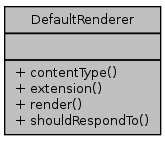|
Stud.IP
3.1 Revision 48552
|
|
Stud.IP
3.1 Revision 48552
|


Public Member Functions | |
| contentType () | |
| extension () | |
| render ($response) | |
| shouldRespondTo ($filename, $media_range=null) | |
Default base content renderer class (outputs text/plain).
Content renderers are output filters that can reshape data before it is sent to the client. Each content renderer is associated with a certain content type and a certain file extension. This is neccessary for content negotiation.
| contentType | ( | ) |
Returns an associated content type.
Reimplemented in DebugRenderer, and JSONRenderer.

| extension | ( | ) |
Returns an associated extension.
Reimplemented in DebugRenderer, and JSONRenderer.

| render | ( | $response | ) |
Response transformation function.
| \RESTAPI\Response | $response | the response to transform |
Reimplemented in DebugRenderer, and JSONRenderer.

| shouldRespondTo | ( | $filename, | |
$media_range = null |
|||
| ) |
Detects whether the renderer should respond to either a certain filename (tests by extension) or to a certain media range.
| String | $filename | Filename to test against |
| mixed | $media_range | Media range to test against (optional, defaults to request's accept header if set) |
